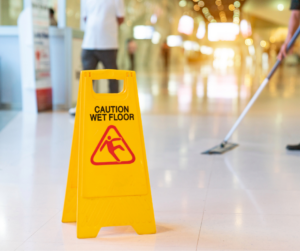June is National Safety Month.
National Safety Month makes an excellent time for small businesses to take this opportunity to recognize the importance of workplace safety. In addition, owners may want to explore a few ways to improve upon their existing safety plans.
Two million American workers get poorly hurt at their place of work every year.
Employers can decrease the risk of their workers experiencing an accident at work. They can do this by implementing a workplace safety plan.
Benefits of a solid safety plan may include:
- Reducing the risk of injury often results in increased productivity. With fewer injuries, employees can report to work regularly with fewer interruptions in their workweek. In addition, employees will not need to take time off for doctor’s office visits and illnesses.
- Expenses such as workers’ compensation premiums can be more affordable when there are little to no claims being filed.
- Implementing safety measures should also keep visits from government officials (OSHA, Department of Labor, etc.) from knocking at the business door.

Small businesses may not have the resources to implement fancy training, draft comprehensive policies, or employ a Safety Officer. However, they are still able to ensure the safety of valuable employees. Business owners and managers will need to evaluate their business operations to identify areas of risk. Upon identifying hazards, employers can draft a safety plan to reduce risk. Companies in different industries will have various sizes of troublesome more extensive than others. For example, manufacturing and construction businesses have risks for accidents that employers can address with safety equipment and other preventative measures. Industries, such as restaurants, have hazards such as slip and fall to burns and wounds from ovens and stove burners. Employees working in administrative roles are at risk for injuries, such as carpal tunnel and other damages that employers and employees can prevent.
Here are seven ways a small business can improve safety in the workplace:
1. Cleanliness (spills)
Eliminating clutter and chaos reduces the risk of tripping on items or slipping when spills occur. Reducing opportunities for accidents means reducing the chances of broken bones or on-the-job injuries.

2. Stress Reduction/mental health
Often overlooked, increased amounts of stress increase fatigue, decreases balance, and decrease coordination. All of this can add up to an increased chance of injury. Furthermore, if an employee who is stressed becomes injured, his or her ability to recover is delayed. When an employee is damaged, the time spent recovering can be increased if the employee is undergoing increased stress. An increase in recovery time prolongs the employee’s time off.
3. Taking regular breaks
Overexertion occurs in all jobs, not just those that are physical. Those in physical positions need to break to stretch. So do those that are in clerical or administrative roles. Carpal tunnel, neck injuries, and more occur from not taking breaks to try. Therefore, your workforce will be prone to minor damage. Add to that the fact that a rested workforce is a more productive workforce. There are many reasons to encourage regular breaks and stretching during the workday.
4. Safety gear and apparel
Personal protective equipment protects workers against safety risks on the job. The type of personal protective equipment required to keep an employee safe varies based on industry. Those in the manufacturing and construction industries know all too well the importance of head and face gear. Accidents that may occur in these industries are life-threatening. Over the past year, we’ve experienced workers in all sectors wear a mask to work with co-workers and support customers. The wearing of face masks was to prevent the spread of COVID19 in the workplace.
5. Labels and signage
Warning signs should be utilized for areas with forklifts, spillage, and other hazards to warn employees about immediate dangers. In addition, employers should post reminders to warn employees of hazards that constantly exist. Such as signs to remind employees to wear their protective gear and be alert in high volume areas where safety hazards present themselves.
6. Regular meetings/check-ins and training
Discussing workplace safety during regular meetings can aid in preventing accidents. Scheduling training quarterly can bring awareness to risk factors. Training can provide education to employees to eliminate or reduce hazards and accidents at work.

7. Reporting/communication
If a safety policy does not already exist, it is a good idea to implement one. The policy should address the reporting of injuries at the workplace. It should also include a process for reporting potential hazards to management.
Involving employees in drafting or updating a safety plan can be an excellent strategy for success. Employees may experience situations in which they are at risk. Bringing potential hazards to the employer’s attention can allow managers to draft measures to prevent accidents and illnesses—engaging employees in creating or updating the company’s safety plan results in a more comprehensive plan. Thus, a safe workplace can be accomplished without increasing the company’s budget.
PaySmart is a payroll provider located in Mechanicsburg, Pennsylvania, supporting small businesses in the Central PA region. We are dedicated to helping small businesses take care of their payroll needs. To learn more information about how PaySmart may provide payroll solutions, please contact us at 717-766-1777. Our New Client Concierge is waiting for you!
